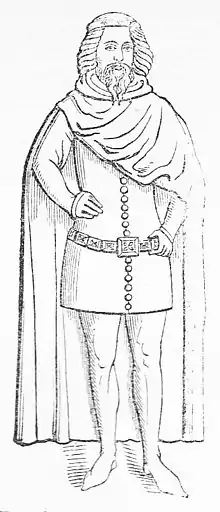Lionel of Antwerp, Duke of Clarence
Lionel of Antwerp, Duke of Clarence, (29 November 1338 – 17 October 1368[1]) was an English prince who served as Lieutenant of Ireland from 1361 to 1366. The third son, but the second to survive infancy, of King Edward III and his wife Philippa of Hainault, he was named after his birthplace at Antwerp in the Duchy of Brabant.[2]
| Lionel of Antwerp | |
|---|---|
| Duke of Clarence | |
 Lionel, Duke of Clarence. 19th-century drawing of bronze statuette on south side of tomb of his father King Edward III in Westminster Abbey | |
| Earl of Ulster | |
| Predecessor | William Donn de Burgh |
| Successor | Philippa with Roger Mortimer |
| co-Ruler | Elizabeth de Burgh |
| Born | 29 November 1338 Antwerp, Duchy of Brabant (now Belgium) |
| Died | 17 October 1368 (aged 29) Alba, Piedmont |
| Burial | Clare Priory, Suffolk |
| Spouse | |
| Issue | Philippa, 5th Countess of Ulster |
| House | Plantagenet |
| Father | Edward III, King of England |
| Mother | Philippa of Hainault |
First marriage
Betrothed as a child to Elizabeth de Burgh, 4th Countess of Ulster (died 1363), daughter and heiress of William Donn de Burgh, 3rd Earl of Ulster, he was married to her in 1352, but before this date, he had entered into possession of her great Irish inheritance. He was called Earl of Ulster from 1347.[3]
Ireland
Having been named as his father's representative in England in 1345 and again in 1346, Lionel joined an expedition into France in 1355, but his chief energies were reserved for the affairs of Ireland.[3]
Appointed governor of that country, he landed at Dublin in 1361, and in November of the following year was created Duke of Clarence, the third dukedom created in England, while his father made an abortive attempt to secure for him the crown of Scotland. His efforts to secure an effective authority over his Irish lands were only moderately successful. After holding a parliament at Kilkenny, which passed the largely unsuccessful Statutes of Kilkenny in 1366, he dropped the task in disgust and returned to England.[3]
The poet Geoffrey Chaucer was at one time a page in Lionel's household.[3]
Second marriage
After Lionel's first wife Elizabeth died in 1363, a second marriage was arranged. He married Violante Visconti, daughter of Galeazzo Visconti, Lord of Pavia, members of the Visconti family. Her brother, Gian Galeazzo Visconti, was the Duke of Milan. Journeying to fetch his bride, Lionel was received in great state both in France and Italy and was married to Violante at Milan in June 1368. Some months were then spent in festivities, during which Lionel was taken ill at Alba, where he died on 17 October 1368.[3] There was strong speculation at the time that he had been poisoned by his father-in-law,[4] although this has never been proven.
Issue
Lionel had only one child, Philippa, daughter of his first wife Elizabeth. In 1368 she married Edmund Mortimer, 3rd Earl of March. Their granddaughter and eventual heir, Anne Mortimer, married into the Yorkist branch of the English royal family and was the mother of Richard Plantagenet, 3rd Duke of York. Even though Richard was a descendant in the male line of Edward III from Edmund of Langley, Lionel's younger brother, the House of York based its claim to the English throne on descent through the female line from Lionel to the English throne. In doing so, the Yorkists were able to present a senior claim to the English throne over the Lancastrian branch of the English royal family, the descendants of another younger brother, John of Gaunt. (Edward III's first-born son, Edward the Black Prince, had no legitimate descendants past his two sons Edward of Angoulême and King Richard II.)[3] Lionel was the ancestor of Kings Edward IV, Edward V, Richard III and all later English, and subsequently British, monarchs except for Henry VII, whose wife Elizabeth of York was Lionel's descendant.
Ancestry
| Ancestors of Lionel of Antwerp, Duke of Clarence | ||||||||||||||||||||||||||||||||||||||||||||||||||||||||||||||||||||||||||||||||||||||||||||||||||||||||||||||||||||||||||||||||||||||||||||||||||||||||||||||||||||||||||||||||||||||||||||||||||||||||||||||||||||||||||||||||||||||||||||||||||||||||||||||||||||||||||||||||||||||||||||||||||||||||||||||||||||||||||||||||||||||||||||||||||||||||||||||||||||||||||||||||||||||||||||||||||||||||||||||||||||||||||||||||||||||||||||||||||||||||||||||||||||||||||||||||||||||||||||||||||||||||||||||||||||||||||||||||||||||||||||||||||||||||||||||||||||||||||||||||||||||||||||||||||||||||||||||||
|---|---|---|---|---|---|---|---|---|---|---|---|---|---|---|---|---|---|---|---|---|---|---|---|---|---|---|---|---|---|---|---|---|---|---|---|---|---|---|---|---|---|---|---|---|---|---|---|---|---|---|---|---|---|---|---|---|---|---|---|---|---|---|---|---|---|---|---|---|---|---|---|---|---|---|---|---|---|---|---|---|---|---|---|---|---|---|---|---|---|---|---|---|---|---|---|---|---|---|---|---|---|---|---|---|---|---|---|---|---|---|---|---|---|---|---|---|---|---|---|---|---|---|---|---|---|---|---|---|---|---|---|---|---|---|---|---|---|---|---|---|---|---|---|---|---|---|---|---|---|---|---|---|---|---|---|---|---|---|---|---|---|---|---|---|---|---|---|---|---|---|---|---|---|---|---|---|---|---|---|---|---|---|---|---|---|---|---|---|---|---|---|---|---|---|---|---|---|---|---|---|---|---|---|---|---|---|---|---|---|---|---|---|---|---|---|---|---|---|---|---|---|---|---|---|---|---|---|---|---|---|---|---|---|---|---|---|---|---|---|---|---|---|---|---|---|---|---|---|---|---|---|---|---|---|---|---|---|---|---|---|---|---|---|---|---|---|---|---|---|---|---|---|---|---|---|---|---|---|---|---|---|---|---|---|---|---|---|---|---|---|---|---|---|---|---|---|---|---|---|---|---|---|---|---|---|---|---|---|---|---|---|---|---|---|---|---|---|---|---|---|---|---|---|---|---|---|---|---|---|---|---|---|---|---|---|---|---|---|---|---|---|---|---|---|---|---|---|---|---|---|---|---|---|---|---|---|---|---|---|---|---|---|---|---|---|---|---|---|---|---|---|---|---|---|---|---|---|---|---|---|---|---|---|---|---|---|---|---|---|---|---|---|---|---|---|---|---|---|---|---|---|---|---|---|---|---|---|---|---|---|---|---|---|---|---|---|---|---|---|---|---|---|---|---|---|---|---|---|---|---|---|---|---|---|---|---|---|---|---|---|---|---|---|---|---|---|---|---|---|---|---|---|---|---|---|---|---|---|---|---|---|---|---|---|---|---|---|---|---|---|---|---|---|---|---|---|---|---|---|---|---|---|---|---|---|---|---|---|---|---|---|---|---|---|---|---|---|---|---|---|---|---|---|---|---|---|---|---|---|---|---|---|---|---|---|---|---|---|---|---|---|---|---|---|---|---|---|---|---|---|---|---|---|---|---|---|---|---|---|---|---|---|---|---|---|---|---|---|---|---|---|---|---|---|---|---|---|---|---|---|---|---|---|---|---|---|---|---|---|---|---|---|---|---|---|---|---|---|---|---|---|---|---|---|---|---|---|---|---|---|---|---|
| ||||||||||||||||||||||||||||||||||||||||||||||||||||||||||||||||||||||||||||||||||||||||||||||||||||||||||||||||||||||||||||||||||||||||||||||||||||||||||||||||||||||||||||||||||||||||||||||||||||||||||||||||||||||||||||||||||||||||||||||||||||||||||||||||||||||||||||||||||||||||||||||||||||||||||||||||||||||||||||||||||||||||||||||||||||||||||||||||||||||||||||||||||||||||||||||||||||||||||||||||||||||||||||||||||||||||||||||||||||||||||||||||||||||||||||||||||||||||||||||||||||||||||||||||||||||||||||||||||||||||||||||||||||||||||||||||||||||||||||||||||||||||||||||||||||||||||||||||
Arms

Lionel's arms were at some point those of the kingdom, differenced by a label argent of five points, with each point bearing a cross gules, thus presenting the flag of England's Saint George's cross on each point[10] There are also suggestions, such as the above image, that at some point he bore a differentiating label argent of three points, each bearing a canton gules.
Notes
- "Lionel of Antwerp, duke of Clarence | English noble". Encyclopedia Britannica. Retrieved 24 January 2018.
- Ormrod 2008.
- Chisholm 1911, p. 248.
- Frances Stonor Saunders, Hawkwood: Diabolical Englishman (2004).
- Armitage-Smith, Sydney (1905). John of Guant: King of Castile and Leon, Duke of Aquitaine and Lancaster, Earl of Derby, Lincoln, and Leicester, Seneschal of England. Charles Scribner's Sons. p. 21. Retrieved 8 October 2018.
- Anselme de Sainte-Marie, Père (1726). Histoire généalogique et chronologique de la maison royale de France [Genealogical and chronological history of the royal house of France] (in French). Vol. 1 (3rd ed.). Paris: La compagnie des libraires. pp. 87–88.}
- Anselme 1726, pp. 381–382
- von Redlich, Marcellus Donald R. Pedigrees of Some of the Emperor Charlemagne's Descendants. Vol. I. p. 64.
- Weir, Alison (1999). Britain's Royal Families: The Complete Genealogy. London: The Bodley Head. pp. 75, 92.
- Marks of Cadency in the British Royal Family
References
- Ormrod, W. M. (January 2008) [2004]. "Lionel, duke of Clarence (1338–1368)". Oxford Dictionary of National Biography (online ed.). Oxford University Press. doi:10.1093/ref:odnb/16750. (Subscription or UK public library membership required.)
Attribution
- This article incorporates text from a publication now in the public domain: Chisholm, Hugh, ed. (1911). "Clarence, Dukes of s.v. Lionel of Antwerp". Encyclopædia Britannica. Vol. 6 (11th ed.). Cambridge University Press. p. 428.
Further reading
- Tout, Thomas Frederick (1893). . Dictionary of National Biography. Vol. 33. pp. 335–338.